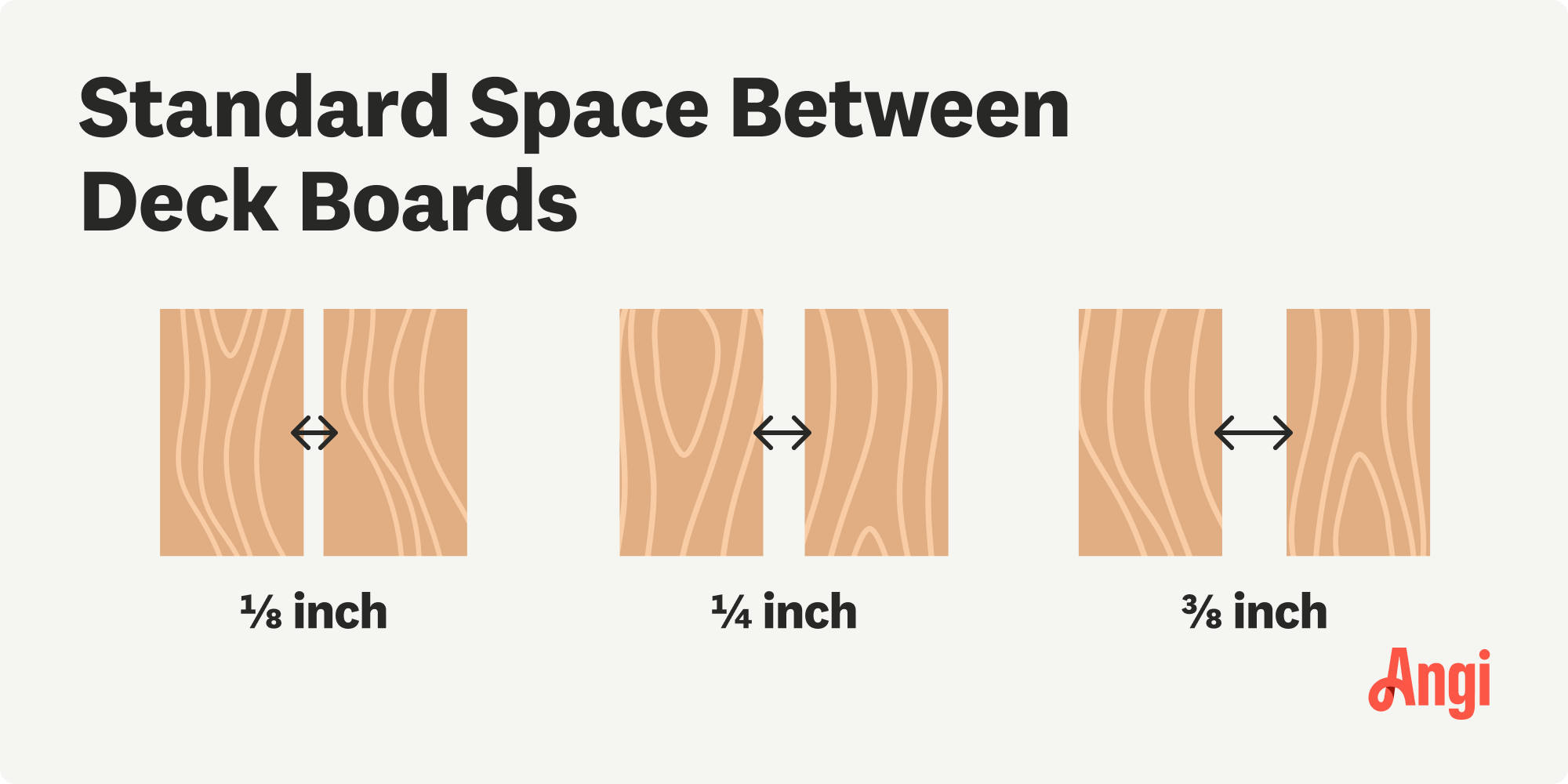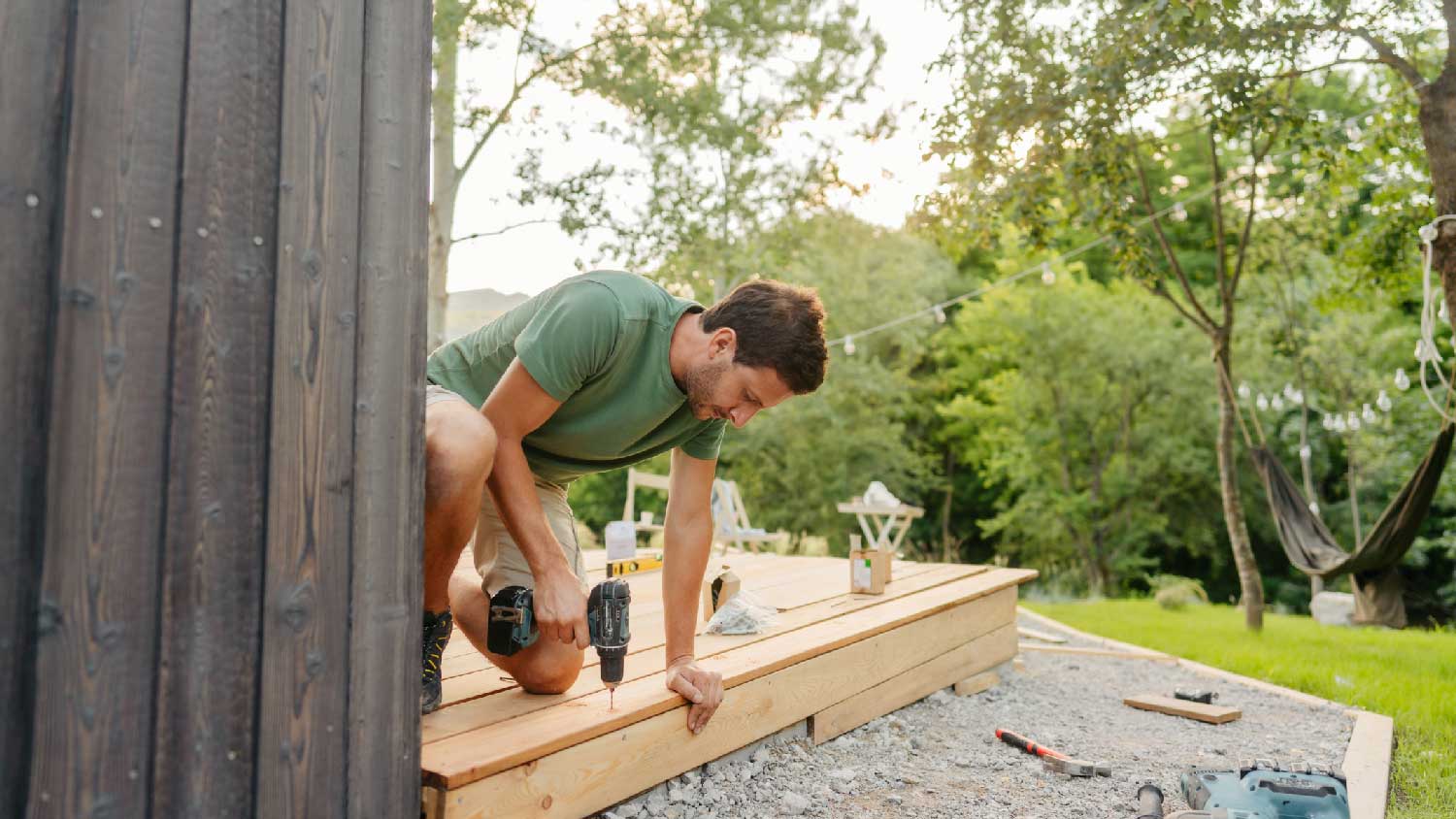Deck replacement costs depend on materials, any structural damage you need to fix, and more. This guide explores how much it costs to replace or repair a deck.
How Much Space Do I Need Between Deck Boards?
Mind the gap for a safe and sturdy deck


Space between deck boards varies from 1/8-inch to 3/8-inch.
How wood boards are dried affects how much they expand or contract, determining the required spacing.
Manufacturers normally advise what spacing you need for composite boards.
Climate, board width, and fastener types also influence how much space you need to leave.
You may have heard horror stories from neighbors who spent days building a new deck only to find the boards buckling, water pooling, and mold rapidly developing on the surface. This could be because they didn’t leave a gap between the boards, or the spacing wasn’t suited to the circumstances. Our guide explaining how much space between deck boards you need will help ensure the surface drains and dries properly.
What Is the Standard Space Between Deck Boards?

There isn’t a standard space between deck boards. Board spacing varies from 1/8-inch to 3/8-inch, depending on the deck material and width, the type of fastener you use, and the local climate.
Board Width
Generally, it’s best to opt for a wider gap for wider deck boards. Bigger deck board sizes have a greater surface area to absorb moisture, leading to more expansion and contraction than you would experience with narrower boards.
The average deck board is 5.5 to 6 inches wide. If you opt for a very narrow, 4-inch wide board for decorative purposes, a 1/8-inch gap is likely sufficient rather than a 1/4-inch one.
Manufacturer’s Instructions
Composite decking boards should come with a spacing recommendation, as well as variations depending on the temperature during installation.
If you install a gap different from their recommendation, you risk voiding the product’s warranty. You could also end up with a space that’s too big—causing a tripping hazard and a space to lose anything you drop on the deck—or one that’s too narrow, leading to drainage issues that can compromise the integrity of the boards over time.
Climate
The time of year and geographical location can affect how much space to leave between deck boards. For example, opting for a slightly larger gap if you’re installing fully dry wood during a hot, dry summer makes sense because it allows for expansion when you move into the wet season.
Temperature changes are another reason to follow the manufacturer’s recommendations for composite decking. If you install the decking during a cold winter, it will likely expand once the temperatures rise in the summer.
Fastener Type
The type of hidden clip fasteners commonly used to attach composite decking can influence how much space to leave between deck boards. Always check what fasteners manufacturers recommend, as this will tie into the appropriate amount of spacing.
Deck Board Space by Material Type

When building a deck, there isn’t a single standard for the space between deck boards. However, there is guidance for the gaps depending on your decking material.
Kiln-Dried Wood Boards
For kiln-dried wood, allowing 1/4-inch space between deck boards is recommended. However, you can go up to 1/2-inch if you prefer this look. This type of wood is dried in a special oven, and the controlled heat, humidity, and airflow levels produce boards with a stable, low moisture content.
While it can still be a good idea to acclimate the boards to your local climate before installing them, the gap between kiln-dried wood boards is less likely to alter because of shrinkage or expansion. Acclimating the boards involves leaving them in a dry area for one to two weeks before installation.
If you’re installing the boards during very hot and dry weather and opting for a 1/4-inch gap, adding an additional 1/16-inch to your measurements can be helpful. This allows for a small amount of expansion when humidity levels rise again.
Air-Dried Wood Boards
You can install air-dried wood boards with a gap between 1/8-inch and 1/4-inch. This is because air-dried boards are more likely to shrink in width than expand, as they contain more moisture than kiln-dried boards.
If you’re installing the boards when humidity levels are high, opt for a 1/8-inch gap; the gap will widen as the boards contract when the climate dries out.
Allowing the air-dried boards to acclimate fully before installation means you can opt for a 1/4-inch gap, as the boards will likely expand. However, air-dried boards can take up to 8 weeks to acclimate to your local climate.
“Green” Wood Boards
If you use "green" wood that hasn’t been air- or kiln-dried, you might install the deck with no spacing between boards. A gap will form through natural shrinkage as the deck dries in the sun over the first month.
Composite Decking
Most composite decking manufacturers recommend a 1/8- to 1/4-inch gap between their boards. This material doesn’t expand and contract as much as natural wood does. The handy thing with composite boards is that they require no guesswork or calculations. Many composite deck manufacturers advise exactly what space between deck boards they recommend.
| Board Material Type | Min Space | Max Space |
|---|---|---|
| Kiln-dried wood | 1/4-inch | 1/2-inch |
| Air-dried wood | 1/8-inch | 1/4-inch |
| “Green” wood | No gap | 1/8-inch |
| Composite | 1/8-inch | 1/4-inch |
How to Measure the Space Between Deck Boards

You’ve worked out the ideal space between deck boards for your project. Now, you have to ensure you install it accurately. Fortunately, there are several techniques for measuring the space between deck boards.
Official deck spacers: Insert these specially designed pieces of plastic between the boards to create the spacing you need.
DIY deck spacers: Use a pencil or appropriately sized nails to create the space you need if you don’t want to buy deck spacers.
Deck board spanner: The angled edge of a deck board spanner helps you create the gap you’re looking for.
Chalk lines: Draw lines to indicate where each board should lie, accounting for spacing. You’ll need a helper to ensure your long lines are perfectly straight.
What to Do If You Have the Wrong Space Between Deck Boards
If you’ve installed your deck only to discover an issue with spacing, you should not ignore the issue. Installing boards with inconsistent or incorrect spacing can lead to problems with appearance—like pooling water, warping, gathering debris—and structural soundness.
If the spacing is not right, removing and reinstalling the boards accurately is the safest option. This ensures you won’t experience aesthetic, longevity, or safety problems further down the line.
If you’re not confident about getting the spacing right in the first place, seek the advice of a professional deck builder near you or have them carry out the installation for you. The average deck repair cost is $2,150—making this a costly mistake if you have to get the pros in to fix it.
The homeowners guide to deck and porch services
From average costs to expert advice, get all the answers you need to get your job done.

Vinyl is a durable and relatively inexpensive choice of decking material. Your vinyl deck cost will depend on labor, the deck size, and more.

Flagstone patio costs vary by the size, material type, labor, and more. Stay tuned to see how much your flagstone patio could cost.

Choosing from all the types of deck railing can be overwhelming. Check out the pros and cons of each so you can pinpoint the best option for you.
 •
•Discover steel deck framing costs, including material, labor, and installation factors. Learn how to budget and choose the best option for your home project.

Many homeowners wonder, "Why are my deck boards warping?" Here are the most common causes, solutions, and the best steps for prevention.

